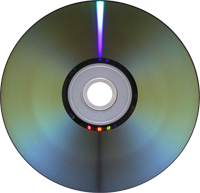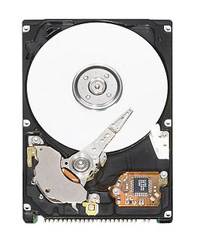 In part one of this article, Matthew Fletcher explained the different connection types for external hard drives, and compared three strategies for backing up your photos.
In part one of this article, Matthew Fletcher explained the different connection types for external hard drives, and compared three strategies for backing up your photos.
In part two of this guide, Matthew explains a few backup options in detail, and provides a few specific recommendations:
DVDs
 One popular method of backing up images is to make a DVD with the original images on it. If you have a DVD burner, this is a good way of making a reliable backup. Burned DVDs can last 30 years or more and are relatively durable. You can either use backup software or manually create backups.
One popular method of backing up images is to make a DVD with the original images on it. If you have a DVD burner, this is a good way of making a reliable backup. Burned DVDs can last 30 years or more and are relatively durable. You can either use backup software or manually create backups.
Since a dual-layer DVD can store about 8.5 gigabytes, which is similar to a common memory card size of up to 8GB, it is worth making a copy of each memory card as you upload the images. Make sure you properly label the DVD for future retrieval.
There are a few things you should consider with DVDs. One is that if your main drive fails, you will need to copy each DVD one at a time, which is very time consuming. It’s also hard to predict the future of technology trends, so it is possible that DVDs will become obsolete and your data may be safe but unreadable.
In summary, DVDs are safe from accidental deletion–so that even if you accidentally delete the folder with all your images in it, you still have a good backup–but slow and have a significant manual component.
Hard Drives

The cheapest and easiest backup method is to use an additional hard drive (either internal or external). Choose a hard drive that is big enough to keep all your current and future images, or be prepared to upgrade your drive in the future. Terabyte drives are common and relatively cheap these days and represent a great option.
Now you need to choose a backup strategy. You could manually copy files onto the new drive as needed or use some software to do it for you automatically. Automatic backup software offers a great hands-off solution allowing you to set up your software and let it take care of your backups. Many external drives come with free software and that is a great place to start.
Mac users can take advantage of Time Machine, which is an automated backup solution that comes with your computer and creates incremental backups of your data and allows you to “go back in time” to retrieve a file that has been changed or lost. Windows users have a variety of other backup software options.
Recommended hard drives:
Hard Drives using RAID
RAID stands for Redundant Array of Independent Disks. Put simply, it uses multiple physical hard drives to provide protection from hardware failure or increased speed of access to your data. If your system allows you to take advantage of RAID, it is well worth the time to set it up.
Mac users can take advantage of RAID with no additional hardware or software as it’s built into the operating system. Windows users will need additional software and possibly hardware to take advantage of RAID.
RAID offers an excellent method of Continuous backup. The simplest RAID model, RAID 1 or Mirrored RAID keeps a copy of your data on two or more disks simultaneously. If one or more disks fails, your data is still accessible on the remaining disk(s) and you can replace the damaged drive(s) to recreate your backup.
RAID 5, 6 and 10 use combinations of mirrored and “striped” drives to create protection and RAID 0 shares the data across multiple drives to improve performance but does not protect your data in any way, so if one disk fails, all your data is lost.
One major disadvantage of RAID is that it is not easy to scale, so if you were to need additional space, you need to rebuild the RAID array from scratch rather than simply adding additional drives to add capacity. Also, RAID disks cannot be read outside of their RAID array.
Backup Appliances

Backup appliances are devices that use one or more backup strategies to keep your data safe. They are devices that attach to your computer directly or through a network and handle all your backups without the need for you to do anything.
Backup appliances are expensive and impractical for most of us, however one notable exception is the Drobo from Data Robotics. While not called a backup appliance, it is a consumer backup solution that provides automatic, scalable RAID protection of your data.
Like any RAID solution, Drobo protects from hardware failure and not accidental deletion but requires little or no experience or expertise to set up and use. Adding capacity is as simple as adding a drive, which requires no screwdrivers and can be done without turning the unit off.
One major advantage of backup appliances, including Drobo, is that they are scalable, so you can add additional storage space quickly and easily–often as simply as adding an additional drive. This is not the case with Hard Drives attached to your computer, where once they are full, you will need to get a bigger hard drive and create a new backup strategy, which can be time consuming.
Backup Appliances are a great solution if you are a professional photographer or really need to keep your data safely backed up at all times. Certainly look into them if you are ready for that next level of data protection.
Data Storage Centers
Data Storage Centers are the kings of backup. They are typically built in buildings that are safe from fire, earthquake and bombs and often in military-style bunkers with strict controls on security.
The key point here is that they are off-site backup solutions so that even if your system was destroyed or stolen, your data remains safe. For businesses that rely on their data, Data Storage Centers may be the best way to go.
For the average consumer, there are web-based storage servers that can keep your most valuable data secure by uploading it and keeping it on their servers. This may be a good solution for you if you don’t have gigabytes of data to upload regularly.
The advantage of Data Storage Centers is that your data is very secure. The disadvantages are that it can take a long time to upload your data, requires a very fast internet connection to be practical and can be expensive.
Examples of Data Storage Centers:
Summary
At the end of the day, you will need to create a strategy that works for you based on price, need and ease-of-use. For most of us, simply adding an external backup drive and using backup software will be infinitely better than not having any backups at all.
A successful backup strategy will be easy to use and have a level of protection relative to the value of your data. Consider how much it would cost to replace your data and images, or what you would pay to recover them should they be lost.
If you enjoyed this article, and would like to read more, please signup for free updates by email or RSS.
 About the Author: Matthew Fletcher has been a naturalist for over 30 years and is a self described “Tasmanian Devil.” Born in Tasmania, Australia, he has lived and worked in seven countries on three continents. Photography has always been a passion, and has enabled him to share his experiences through his images. These days you can find Matthew ‘down under’ hiking through the Tasmanian bush, so if you see him, stop & say G’Day.
About the Author: Matthew Fletcher has been a naturalist for over 30 years and is a self described “Tasmanian Devil.” Born in Tasmania, Australia, he has lived and worked in seven countries on three continents. Photography has always been a passion, and has enabled him to share his experiences through his images. These days you can find Matthew ‘down under’ hiking through the Tasmanian bush, so if you see him, stop & say G’Day.
Leave a Reply